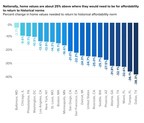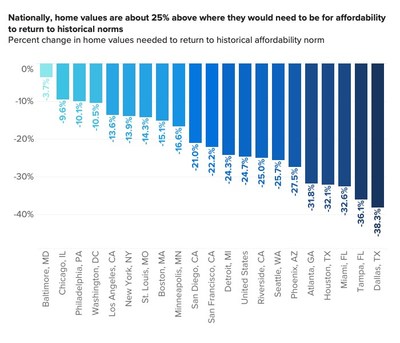Press releases
Home values are 25% above affordability norms
Oct 20, 2022
A substantial home value correction is very unlikely
- The share of income required to afford a mortgage has risen to 30.2%, well above the norm of 22.8%.
- Nationally, home values are about 25% above where they would need to be for affordability to return to normal. It is extremely unlikely home values will fall to this degree. Zillow forecasts home value growth will be nearly flat over the next 12 months.
- A sharp inventory increase would be needed for home values to fall dramatically. However, there have been roughly 11% fewer new listings on the market so far this year compared to 2019.
SEATTLE, Oct. 20, 2022 /PRNewswire/ -- Housing affordability is the worst it has been in several years, and many buyers are pulling back, hoping relief is around the corner. A new analysis by Zillow® shows home values are 24.7% above where they would need to be for affordability to return to recent norms.1 A shock of this size is extremely unlikely, so buyers may need to reset their expectations.
The monthly mortgage payment on a typical U.S. home is about $1,850 — that is 75.5%, or about $800, higher than it was a year ago.2 Home values have fallen a bit since the peak in June, but rising mortgage rates have overwhelmed those small affordability gains. Mortgage affordability — the share of income a median household would need to spend on a typical mortgage payment — has risen to 30.2% nationally, even before including the cost of taxes and insurance. That is above the 30% threshold for households to be considered cost burdened, and much higher than the 2005–2021 average of 22.8%.
"The next several years appear set up for affordability to be a major challenge for home buyers," said Zillow senior economist Nicole Bachaud. "Inventory remains tight, real income growth is dismal, mortgage rates show no signs of dropping, and there is plenty of pent-up demand ready to bid prices back up if they reach a level would-be buyers can once again afford. Filling the housing deficit continues to be the key to long-term affordability, but the recent slowdown in single-family construction is not a good sign that the market is getting closer to building enough to meet demand."
For mortgage affordability to return to the 22.8% norm nationally, U.S. home values would need to fall 24.7%. Some markets are much closer to their historical affordability norms — for example, Hartford home values are only 2.4% higher than where they would need to be, and in Baltimore, they are 3.7% higher — but others have seen affordability deteriorate much more. Salt Lake City, Nashville, Dallas and Las Vegas are furthest away from their historical affordability, at least 37% above where they would need to be to once again reach that level.
Far from a significant drop, Zillow's home value forecast calls for home values to remain nearly flat in the 12 months ending September 2023. It would take a sharp increase in inventory for home values to fall dramatically. That is simply not the case right now. Overall inventory is ticking up, but it remains nearly 40% below pre-pandemic levels and is nowhere near a glut that would put the market in a position for significant price drops.
New listings are coming onto the market at a mere trickle, down 16% in September compared to a year prior. In 2022 to date, there have been about 11% fewer homes listed than at this point in 2019. Many homeowners have mortgages with low rates from purchasing or refinancing earlier in the pandemic, and have very little financial incentive to sell while mortgage rates are this high. Most also have significant equity in their homes, which makes it unlikely that a large number of properties will be forced into distressed sales, like many were during the Great Recession.
The housing market slowdown is being driven by discouraged buyers pulling back as their budgets are stretched. Some buyers simply have been priced out of today's market, but those who are waiting for affordability to improve will likely have a long wait ahead of them. If home values continue to fall, buyers will likely reenter the market and drive values back up. And while mortgage rates are nearly impossible to predict, inflation pressures remain strong, and it's perhaps a better bet that rates will rise further than come back down.
Affordability is clearly a major challenge for home buyers. The silver lining is that first-time buyers who can overcome these steep obstacles have an opportunity to shop with more bargaining power, less chance of a bidding war and more time to consider their options. Zillow has gathered tools that can help shoppers make the leap to homeownership on one easy-to-navigate web page.
|
Metro Area |
Typical |
Median |
Mortgage |
Mortgage |
Home Value |
|
United States |
$358,283 |
$71,895 |
30.2 % |
22.8 % |
-24.7 % |
|
New York, NY |
$619,774 |
$83,696 |
44.9 % |
38.8 % |
-13.9 % |
|
Los Angeles–Long |
$895,380 |
$84,760 |
64.1 % |
55.5 % |
-13.6 % |
|
Chicago, IL |
$311,696 |
$78,831 |
24.0 % |
21.7 % |
-9.6 % |
|
Dallas–Fort |
$389,153 |
$78,572 |
30.1 % |
18.6 % |
-38.3 % |
|
Philadelphia, |
$339,514 |
$83,765 |
24.6 % |
22.2 % |
-10.1 % |
|
Houston, TX |
$313,521 |
$70,849 |
26.9 % |
18.3 % |
-32.1 % |
|
Washington, DC |
$551,350 |
$113,805 |
29.4 % |
26.4 % |
-10.5 % |
|
Miami–Fort |
$477,984 |
$65,653 |
44.2 % |
29.8 % |
-32.6 % |
|
Atlanta, GA |
$382,424 |
$82,963 |
28.0 % |
19.1 % |
-31.8 % |
|
Boston, MA |
$651,398 |
$104,440 |
37.8 % |
32.2 % |
-15.1 % |
|
San Francisco, |
$1,375,410 |
$114,843 |
72.7 % |
56.7 % |
-22.2 % |
|
Detroit, MI |
$239,993 |
$69,585 |
20.9 % |
15.9 % |
-24.3 % |
|
Riverside, CA |
$570,079 |
$80,600 |
42.9 % |
32.3 % |
-25.0 % |
|
Phoenix, AZ |
$451,313 |
$82,078 |
33.4 % |
24.3 % |
-27.5 % |
|
Seattle, WA |
$757,495 |
$107,025 |
42.9 % |
32.0 % |
-25.7 % |
|
Minneapolis– |
$371,712 |
$89,410 |
25.2 % |
21.1 % |
-16.6 % |
|
San Diego, CA |
$879,980 |
$95,696 |
55.8 % |
44.2 % |
-21.0 % |
|
St. Louis, MO |
$244,924 |
$72,220 |
20.6 % |
17.7 % |
-14.3 % |
|
Tampa, FL |
$391,114 |
$66,844 |
35.5 % |
22.7 % |
-36.1 % |
|
Baltimore, MD |
$377,121 |
$88,843 |
25.8 % |
24.9 % |
-3.7 % |
|
Denver, CO |
$622,434 |
$92,723 |
40.7 % |
28.1 % |
-31.3 % |
|
Pittsburgh, PA |
$209,094 |
$69,231 |
18.3 % |
15.6 % |
-14.9 % |
|
Portland, OR |
$565,487 |
$88,688 |
38.7 % |
30.9 % |
-20.3 % |
|
Charlotte, NC |
$388,986 |
$73,491 |
32.1 % |
20.5 % |
-36.3 % |
|
Sacramento, CA |
$591,512 |
$91,016 |
39.4 % |
33.1 % |
-16.3 % |
|
San Antonio, TX |
$340,964 |
$68,488 |
30.2 % |
21.4 % |
-29.4 % |
|
Orlando, FL |
$402,021 |
$66,798 |
36.5 % |
24.3 % |
-33.6 % |
|
Cincinnati, OH |
$265,795 |
$72,786 |
22.2 % |
17.1 % |
-22.9 % |
|
Cleveland, OH |
$220,205 |
$67,671 |
19.7 % |
17.0 % |
-14.2 % |
|
Kansas City, |
$288,727 |
$75,507 |
23.2 % |
17.1 % |
-26.3 % |
|
Las Vegas, NV |
$433,068 |
$62,328 |
42.2 % |
26.5 % |
-37.3 % |
|
Columbus, OH |
$306,419 |
$74,774 |
24.9 % |
18.3 % |
-26.6 % |
|
Indianapolis, IN |
$276,020 |
$77,415 |
21.6 % |
16.5 % |
-23.9 % |
|
Austin, TX |
$553,280 |
$90,526 |
37.1 % |
23.9 % |
-35.8 % |
|
Virginia Beach, |
$335,226 |
$74,242 |
27.4 % |
24.2 % |
-12.0 % |
|
Nashville, TN |
$455,447 |
$73,093 |
37.8 % |
22.9 % |
-39.4 % |
|
Providence, RI |
$452,022 |
$73,178 |
37.5 % |
29.6 % |
-21.1 % |
|
Milwaukee, WI |
$269,220 |
$68,327 |
23.9 % |
19.3 % |
-19.4 % |
|
Jacksonville, FL |
$380,452 |
$67,964 |
34.0 % |
21.8 % |
-36.1 % |
|
Memphis, TN |
$236,039 |
$54,158 |
26.4 % |
17.4 % |
-34.4 % |
|
Oklahoma City, |
$222,517 |
$61,676 |
21.9 % |
16.6 % |
-24.5 % |
|
Louisville– |
$244,904 |
$64,796 |
22.9 % |
17.9 % |
-22.2 % |
|
Hartford, CT |
$321,994 |
$89,126 |
21.9 % |
21.4 % |
-2.4 % |
|
Richmond, VA |
$343,978 |
$79,768 |
26.2 % |
22.4 % |
-14.5 % |
|
New Orleans, |
$269,527 |
$54,801 |
29.8 % |
23.6 % |
-20.9 % |
|
Buffalo, NY |
$245,515 |
$63,440 |
23.5 % |
16.7 % |
-29.2 % |
|
Raleigh, NC |
$450,960 |
$88,352 |
31.0 % |
21.6 % |
-30.4 % |
|
Birmingham, AL |
$250,875 |
$62,720 |
24.3 % |
19.3 % |
-20.7 % |
|
Salt Lake City, |
$584,819 |
$79,183 |
44.8 % |
26.9 % |
-40.2 % |
|
*Table ordered by market size |
1 Recent norms indicate the historical average (2005–2021) share of median household income needed for a mortgage payment (principal and interest only) on the typically valued home. The home value change needed to return to affordability norms assumes incomes do not change.
2 Monthly principal and interest on a 30-year fixed-rate mortgage for the typical U.S. home as of September 2022, assuming a 20% down payment and the interpolated average 30-year interest rate reported by Freddie Mac’s Primary Mortgage Market Survey on the last day of the month.
About Zillow Group
Zillow Group, Inc. (NASDAQ: Z and ZG) is reimagining real estate to make it easier to unlock life's next chapter. As the most visited real estate website in the United States, Zillow® and its affiliates offer customers an on-demand experience for selling, buying, renting, or financing with transparency and ease.
Zillow Group's affiliates and subsidiaries include Zillow®; Zillow Premier Agent®; Zillow Home Loans™; Zillow Closing Services™; Trulia®; Out East®; StreetEasy®; HotPads®; and ShowingTime+™, which houses ShowingTime®, Bridge Interactive®, and dotloop®. Zillow Home Loans, LLC is an Equal Housing Lender, NMLS #10287 (www.nmlsconsumeraccess.org).
SOURCE Zillow

For further information: Alex Lacter, Zillow, press@zillow.com




